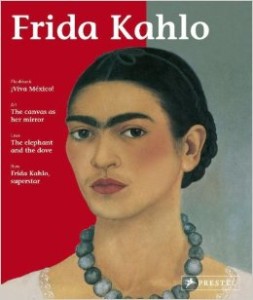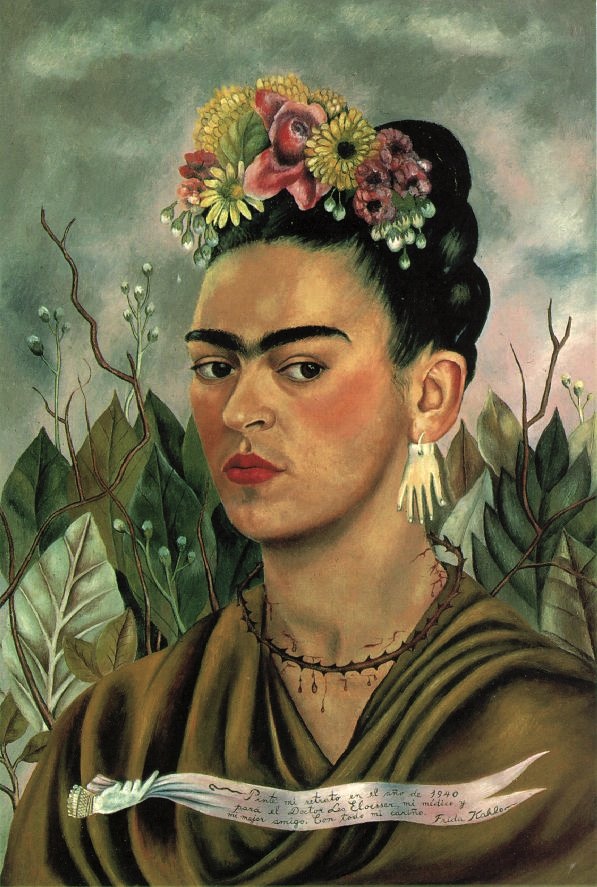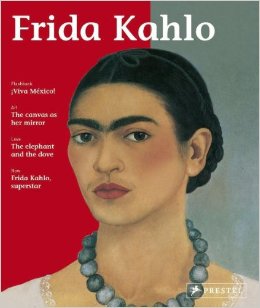 Frida Kahlo
Frida Kahlo
by Claudia Bauer
(translated by Stephen Telfer)
Prestel Verlag. 128 pages, $14.95
MEXICAN PAINTER Frida Kahlo (1907-1954) has had an impressive posthumous life. Actual photos and descriptions of her are as colorful as her paintings, which fit uneasily into a broadly surrealist category. She was largely self-taught and refused to identify herself with any “bourgeois” school of art.
Kahlo was a Mexican nationalist, a staunch communist, and a bisexual before it was hip. Several movies have been made about her life, most recently (and memorably) one with Salma Hayek in the simply titled Frida (2002), which won two Oscars. Hayek played the title role, striking in the film an uncanny resemblance to the Kahlo of the numerous self-portraits, whose luxuriant hairiness includes her signature unibrow and faint moustache. Her direct gaze—in her own work and in photographs taken by her various friends and lovers—is compelling.
Frida Kahlo, a paperback about Kahlo’s life and art, is an affordable art book. It’s full of good reproductions of her work that accompany a simple biographical narrative, so that we know which paintings followed which events. This guidebook seems to be written for readers with a high-school vocabulary, and it would make an engaging introduction to the painter’s life for someone with no previous knowledge of Kahlo or of her cultural milieu.
The book is divided into chapters, with an italicized summary at the beginning of each. Chapter One, “Viva Mexico!” begins thus: “For Mexico, as for many other countries worldwide, the early years of the 20th century were turbulent and often violent. Political revolution cleared the way for a new type of art whose pioneers became national idols. These heady years bred a rebellious spirit: Frida Kahlo.”
The Casa Azul (blue house) in Mexico City where Kahlo grew up has been a museum and a shrine to her legacy almost since her death in  1954. The book ends with attractive photographs of several of its rooms, kept as they were in her lifetime. This house was her home base, and she returned there several times throughout her adult life as a chronic invalid after the devastating accident in 1925 that fractured many of her bones, including several vertebrae, and which precipitated numerous reconstructive surgeries.
1954. The book ends with attractive photographs of several of its rooms, kept as they were in her lifetime. This house was her home base, and she returned there several times throughout her adult life as a chronic invalid after the devastating accident in 1925 that fractured many of her bones, including several vertebrae, and which precipitated numerous reconstructive surgeries.
This book, like others about Kahlo, pays tribute to her ability to transmute physical and emotional pain into art. Less convincingly, it describes her in terms of her current image as an “independent woman” of the early 20th century, one who supposedly followed her own path to success. Her popular exhibitions are trotted out to support this image, and so are her colorful affairs with both men and women.
However, the facts of Kahlo’s life and the themes of many of her paintings show the crazy-making pain of her love for Diego Rivera, her mentor and then her husband, who had affairs with numerous women (including Kahlo’s sister) throughout their marriage. In traditional patriarchal style, Diego took care of Kahlo whenever she was in a physical crisis but refused to limit himself to one woman. While he could accept her affairs with women, he ended several of her affairs with men by threatening them. These facts, based on written testimony from Kahlo and Diego as well as others in their circle, have been discussed at greater length by other biographers.
The paintings themselves invite a biographical interpretation. Ultimately, it is impossible to judge whether Kahlo’s frequent physical relapses were caused mainly by physical injuries that never healed adequately or by emotional wounds which could never heal in the context of a relationship between two people with clashing needs.
Frida Kahlo acknowledges that the artist’s death, officially described as the logical result of a long decline, might have been an assisted suicide. Like Sylvia Plath, a contemporary writer who also acquired cult status after her early death by suicide, Kahlo emerged as a martyr to heterosexual love as well as to art. Both the life and the work of Frida Kahlo are undeniably moving, and her art speaks more eloquently than the volumes of print that have been devoted to her. However, neither happiness nor emotional independence is easy to find there.
Jean Roberta is a widely published writer based in Regina, Saskatchewan.
Mexico City Discovery: The Gay & Lesbian Review is excited to announce it will be hosting a trip to Mexico City in March 2017 along with Robert Sharp of OUT Adventures, which will include a tour through Frida Kahlo’s Casa Azul. For more info, click here.






Discussion1 Comment
Kahlo demonstrates an uncanny vision of female independence. It is revolutionary to show that male dominance is hidden somewhere in the shadow behind female integrity, wisdom and beauty. She shows a very mature aptitude for a pronounced state of liberation in an uncanny and colorful spirit of female courgae and diplomacy. It is this assertion by Kahlo that women’s perseverance is reinforced by their divine credulousness, so that in considering conditions of male inferiority, their affinity to motivational nd spiritual drives is one which has them look up to and adhere to values constructed by women.